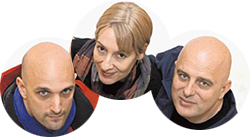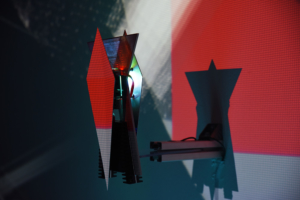PostGravityArt
 POSTGRAVITYART is a term coined by a group of artists: Dragan Živadinov, Dunja Zupančič and Miha Turšič.
POSTGRAVITYART is a term coined by a group of artists: Dragan Živadinov, Dunja Zupančič and Miha Turšič.
They began to develop postgravity art, art that emerges in conditions without gravity, with Noordung::1995-2045, a fifty-year theatre project which is to be repeated, the same day, every ten years, till 2045.
Noordung::1995-2045 premiered in 1995 in Ljubljana. The first repeatition, in 2005, was moved from the original stage to the model of the International Space Station (ISS) in the hydro laboratory at Star City (Russia). The second repeatition was performed in 2015 at KSEVT in Vitanje, the Cultural Centre of European Space Technologies that was opened in 2012 in Slovenia and operates at the intersection of artistic, scientific, cultural and space-related topics. In the remaining three decades, all fourteen actors will be replaced by technological substitutes which in turn will be placed in the Earth’s orbit at the end of the project. In 2045, during the fifth and last repeatition, Dragan Živadinov, co-founder of the Neue Slowenische Kunst, who is a candidate cosmonaut since 1998 (Yuri Gagarin Cosmonaut Training Centre, Star City), will use a spacecraft to convey 14 satellites/umbots into geostationary orbit, from where they will transmit signals to Earth and deep space. Now, inside its 50-year theatre project, Postgravityart is launching its first satellite Umbot::MG, that is a substitute for the actress Milena Grm, who passed away in 2011.
Dragan Živadinov (SI) is a theatre director from Ljubljana. He was a cofounder of the art movement NSK in 1985. During the ’80s he constructed the style “retro-gardism”. In 1983, he founded the retro-garde Theatre of Scipio Nasica’s Sisters, and in 1987, the cosmokinetic observatory Red Pilot. In the early ’90s, he constructed “informances” and transformed Red Pilot into the Noordung Cosmokinetic Cabinet. In 1995, he embarked on the 50-year theatrical process Noordung 1995-2045, through the style of “telecosmism.” In 1998 he became a candidate cosmonaut, and in 1999 realised Biomechanics Noordung, the first complete theatre production in zero-gravity conditions. Since 2000, he has been constructing post-gravitational theatrical abstracts, in 2005, he staged the first reprise in Yuri Gagarin Cosmonaut Training Center, Star City and in 2015 second reprise in KSEVT, Vitanje.
Dunja Zupančič (SI) graduated with a thesis on Eisenstein and the Russian avant-garde. During the ’80s, using processes involving the montage of abstract textures and the construction of composites, she produced pictures of monumental size. During the ’90s, using the engineering of pneumatic and hydraulic elements, she constructed mechatronic abstracts and art satellites (umbots). On December 15, 1999, she visualised and materialised Biomechanics Noordung, the first complete theatrical production performed in conditions of zero-gravity. Since 2000, she has devoted herself to substitutes of corporeality, which she translates into amorphous structures with the help of digital tools. In 2007, she devised an art satellite/technological demonstrator for a 50-year theatre production.
Miha Turšič (SI) was first involved into worldwide product and brand development. Since 2004 he is dedicated to the research of artistic methodologies and practices in outer space, developing post-gravity art and facilitation of space culturalisation. In his career he co-founded several institutions in field of research, development and art. He was cofounder and director of Cultural Centre of European Space Technologies (KSEVT) from 2010 until 2015.
Roscosmoe as part of the Umbot::MG art satellite mission
 Umbot::MG mission by Postgravityart aims to mutually research artistic and scientific understanding of human substitute for outer space conditions. The research follows epistemic research of the human condition in outer space.
Umbot::MG mission by Postgravityart aims to mutually research artistic and scientific understanding of human substitute for outer space conditions. The research follows epistemic research of the human condition in outer space.
The central part of Umbot::MG will be an Artistic Orbital Experiment (AOE) that will research an autonomous system intertwining biological, biographical and biomechatronic data of actors from the Noordung::1995-2005 theatre project. AOE aims to research data sets of all three manifestations in Earth’s orbit conditions. The biological part of AOE will intertwine with the Scientific Experiment (SE), which aims to research the behaviour of an autonomous ecological system in orbital microgravity conditions.
The scientific experiment within the Umbot::MG mission focuses on a research of Symsagittifera roscoffensis plant-animal worms that naturally live in coastal areas with high tides. S. roscoffensis has some “out of this world” capabilities, from the regeneration of organs (including brains), symbiotic coexistence with algae within its body that fulfils all its metabolic requirements, and a special gyroscopic organ that gives them the ability to navigate in extreme tides that vary for about 2-8 meters daily. With the low tide, the worm swims on the surface and burrows down when the tide is high, even in a laboratory environment. Such behaviour can be used as a comparative model to observe the influence of the environment on the organism. Due to the high level of self-sustainability, the selected organism mostly requires a light source, seawater (can be analogue made on site) and essential nutrients/vitamins.
The Umbot::MG mission development is supported by the Research Centre of the Slovenian Academy of Sciences and Arts and was first presented in public at the 8th Triennale of Contemporary Slovene Arts U3 in 2016, curated by Boris Groys.


